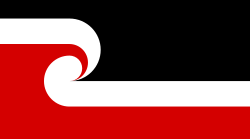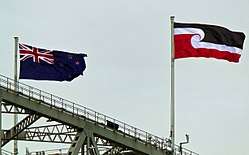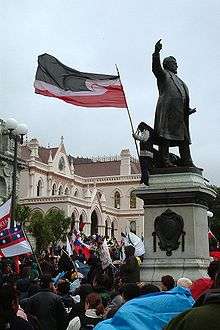Tino rangatiratanga
Tino rangatiratanga is a Māori language term that is often translated as 'absolute sovereignty’ [1]. It appears in the Māori version of the Treaty of Waitangi, signed by the British Crown and Māori chiefs (rangatira) in 1840. It has become one of the most contentious phrases in retrospective analyses of the Treaty, amid debate surrounding the obligations agreed to by each signatory.[2][3] The phrase features in current historical and political discourse on race relations in New Zealand, and is widely used by Māori advocacy groups. A flag based on tino rangatiratanga was designed in 1990, and has become accepted as a national flag for Māori groups across New Zealand.[4]


Origins and etymology
A rangatira is a chief, the nominalising suffix -tanga makes the word an abstract noun referring to the quality or attributes of chieftainship, and the addition of intensifier tino in this context means the phrase can be translated as 'highest chieftainship' (Kawharu, 1989, p. 314), the intention of which was to 'emphasize to a chief the Queen's intention to give the complete control according to their customs' (ibid., p. 319).[5] The term's English translation is 'absolute (tino) sovereignty (rangatiratanga)', although many also refer to it as self-determination,[6] autonomy,[7] or Māori independence.
- Tino: absolute ... used before a noun to indicate something is unrivalled or is true or genuine.
- Rangatiratanga: kingdom, realm, sovereignty, principality, self-determination, self-management.
Treaty of Waitangi
The emphasis on tino rangatiratanga draws from an inconsistency arising between Article 1 and Article 2 of the Treaty of Waitangi:
- In the English text of Article 1 of the Treaty, the Māori signatories cede their sovereignty to the British Crown. For the Māori text, since there was no direct Māori translation for the idea, the missionary neologism 'kawanatanga' (= 'governorship') was used to represent the concept of sovereignty. That word was based on the transliteration "Kawana" (= 'governor'), which had been invented by Bible translators to explain Pontius Pilate's authority in Judaea. Kawana had also been used prior to 1840 to describe the Governor of New South Wales.
- In the English text of Article 2, signatories are assured that the full exclusive and undisturbed possession of their Lands and Estates Forests Fisheries and other properties would remain for so long as they chose. In the Māori text, signatories are assured that their tino rangatiratanga will remain undisturbed over their lands, kainga and other taonga (te tino rangatiratanga o ratou wenua o ratou kainga me o ratou taonga katoa, literally the absolute chieftainship of your lands, your homes, and all your treasures/taonga).
Based on the Māori text alone, in Article 1, the signatories appear to be granting kawanatanga (governorship), and in Article 2, the signatories are promised that their tino rangatiratanga (absolutely sovereignty or highest chieftainship) would remain undisturbed. The apparent inconsistency led to much debate as to whether the Māori signatories intended to cede their sovereignty to the British Crown at all: a debate now definitively resolved by the Waitangi Tribunal ruling that sovereignty was not (indeed could not) be ceded [8].
Aside from the legal controversy, many Māori see the Treaty as a charter to choose their own way of life within the framework of law, free of external interference in taonga like language and culture.
Flag

The Tino Rangatiratanga flag is often referred to as the Māori flag,[9] one which can be used to represent all Māori. Hiraina Marsden, Jan Smith and Linda Munn designed this flag in 1990.[10] It uses black, white and red as national colours of New Zealand. The design of the flag references the Māori creation story of Rangi and Papa, suggesting the sky, the earth, and the physical realm of light and being which was created when they were separated.[11]
The official recognition of the Tino Rangatiratanga flag resulted from a campaign by indigenous rights advocacy group Te Ata Tino Toa.[12] The group applied for the Tino Rangatiratanga flag to fly on the Auckland Harbour Bridge on Waitangi Day. Transit New Zealand, then the government agency responsible for the bridge, declined on the basis that the flag did not represent a country recognised by the United Nations. After considerable debate in the public arena the group adopted diverse tactics to raise awareness of the issues, including lobbying Transit NZ and Parliament,[13][14] submissions to the Human Rights Commission and holding an annual 'Fly the Flag' competition,[15] to more direct protest actions including bungee jumping off the Harbour Bridge, traffic jamming the Harbour Bridge, and flying the largest Tino Rangatiratanga flag ever made over the Harbour Bridge. Key organisers of the campaign included Tia Taurere, Gareth Seymour and Teanau Tuiono.
On 14 December 2009, Prime Minister John Key and Māori Affairs Minister Pita Sharples announced that the Māori Tino Rangatiratanga flag was chosen to fly from the Auckland Harbour Bridge and other official buildings (such as Premier House) on Waitangi Day. The announcement followed a Māori Party–led promotion and series of hui on which Māori flag should fly from the bridge. 1,200 submissions were received, with 80 per cent of participants in favour of the Tino Rangatiratanga flag as they preferred the Māori flag.[16]
Key said the Māori flag would not replace the New Zealand flag but would fly alongside it to recognise the partnership the Crown and Māori entered into when signing the Treaty of Waitangi. "No changes are being made to the status of the New Zealand flag," Mr Key said. Monarchy New Zealand said the move would be "potentially divisive" and AUT University Doctor Paul Moon was critical of the move.[17]
Sharples said the Māori flag was a simple way to recognise the status of Māori as tangata whenua (people of the land). "However, the New Zealand flag remains the symbol of our nation, and there is no intention to change this, nor to diminish the status of our national flag."
The Ministry of Culture and Heritage published guidelines describing the appropriate way to fly the Māori flag in relation to the New Zealand flag.[18]
References
- "The Treaty of Waitangi and New Zealand Citizenship". New Zealand Centre for Political Research. 29 January 2017. Retrieved 12 April 2020.
- "1. – Treaty of Waitangi – Te Ara Encyclopedia of New Zealand". Teara.govt.nz. 13 July 2012. Retrieved 11 August 2015.
- Orange, Claudia (13 July 2012). "Story: Treaty of Waitangi: Page 1 – Creating the Treaty of Waitangi". Te Ara: The Encyclopedia of New Zealand. Wellington, New Zealand: Ministry for Culture and Heritage. Archived from the original on 9 July 2015. Retrieved 7 August 2015.
- "Flags". Te Ara: The Encyclopedia of New Zealand. 13 January 2016. Retrieved 7 March 2016.
- Kawharu, I. H. (1989). Waitangi: Māori and Pākēha perspectives of the Treaty of Waitangi. Auckland, New Zealand: Oxford University Press.
- Awatere, D. (1982). Maori sovereignty. Broadsheet, 100, 38–42.
- Waitangi Tribunal (1996). The Taranaki report: Kaupapa tuatahi (Wai 143) (PDF) (Report). Wellington, New Zealand. Retrieved 9 August 2010.
- "Treaty Signatories Did Not Cede Sovereignty in February 1840 – Tribunal". Te Roopu Whakamana i te Tiriti o Waitangi (Waitangi Tribunal). 14 February 2014. Retrieved 12 April 2020.
- Manatū Taonga Ministry for Culture and Heritage. "Flags of New Zealand Page 6 – The national Māori flag". New Zealand History. Retrieved 12 October 2018.
-
Dignan, James. "Tino Rangatiratanga flag". Flags of the World. Retrieved 31 March 2015.
It was designed in 1990 by Hiraina Marsden, Jan Smith and Linda Munn, and was the winning design in a national contest to find a "Māori Flag".
- "New Zealand – Maori Flags". Crwflags.com. Retrieved 11 August 2015.
- "Te Haki – The Māori flag". Indigenous Portal. Retrieved 14 December 2011.
- Sina Ana Brown-Davis, Spokesperson for Te Ata Tino Toa. "Letter To Dr Sharples About Flying The Maori Flag". Retrieved 14 December 2011.
- Transit NZ. "Letter: Request for Support (Transit NZ and the Maori flag)" (PDF). Retrieved 14 December 2011.
- "The Maori Flag Flies On Waitangi Day". Scoop.co.nz. Retrieved 14 December 2011.
- Colin Espiner (14 December 2009). "Maori flag to fly on Waitangi Day". The Dominion Post.
- "Maori Flag Decision Defended By Prime Minister". Radio New Zealand. 9 December 2009. Retrieved 24 January 2012.
- "Ministry of Culture and Heritage guidelines". Mch.govt.nz. Retrieved 11 August 2015.